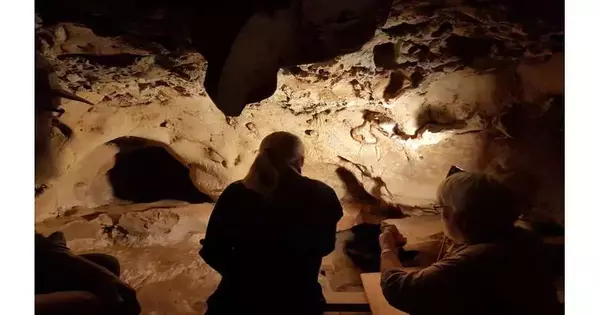According to a study by Jean-Claude Marquet of the University of Tours, France, and colleagues, which was published on June 21, 2023, in the open-access journal PLOS ONE, the oldest known engravings made by Neanderthals can be found on a cave wall in France.
The cultural complexity of Neanderthals has been the subject of extensive research over the past few decades. However, their artistic or symbolic expression is poorly understood. Neanderthals are only known to have produced a small number of symbolic works, and how these works are interpreted is frequently up for debate. In this study, Marquet and his colleagues found the oldest known Neanderthal engravings on a cave wall in France.
A series of non-figurative wall markings in the cave of La Roche-Cotard in the Center-Val de Loire region of France have been interpreted as finger-flutings—marks made by human hands. Using photogrammetry and plotting analysis, the researchers created 3D models of these markings and compared them to both experimental and known human markings. The team came to the conclusion that these engravings are deliberate, organized, and intentional shapes that were created by human hands based on their shape, spacing, and arrangement.
3D Animation Model: The Roche-Cotard cave’s main decorated wall
The team also used optically stimulated luminescence dating to date cave sediments. They found that the cave was filled in about 57,000 years ago, long before Homo sapiens arrived in the area. This, in addition to the cave’s only stone tools being Mousterian, a Neanderthal technology, is strong evidence that these engravings were made by Neanderthals.
The purpose of these symbols is a mystery due to the fact that they are not figurative. However, they are of the same age as cave drawings that Homo sapiens made in other parts of the world. This adds to the growing body of evidence demonstrating that Neanderthal behavior and activities were as diverse and complex as those of our own ancestors.

Credit: Jean-Claude Marquet, CC-BY 4.0 (creativecommons.org/licenses/by/4.0/)
Illustrations of engravings found in the Roche-Cotard cave in the Indre-et-Loire region of France The “circular panel” (ogive-shaped tracings) can be found on the left, and the “wavy panel” (two parallel tracings forming sinuous lines) can be found on the right. Credit: The authors add, “Fifteen years after the resumption of excavations at the La Roche-Cotard site, the engravings have been dated to over 57,000 years ago and, thanks to stratigraphy, probably to around 75,000 years ago, making this the oldest decorated cave in France, if not Europe.” Jean-Claude Marquet, CC-BY 4.0 (creativecommons.org/licenses/by/4.0/).
More information: Marquet J-C, Freiesleben TH, Thomsen KJ, Murray AS, Calligaro M, Macaire J-J, et al. The earliest unambiguous Neanderthal engravings on cave walls: La Roche-Cotard, Loire Valley, France, PLOS ONE (2023). DOI: 10.1371/journal.pone.0286568.





